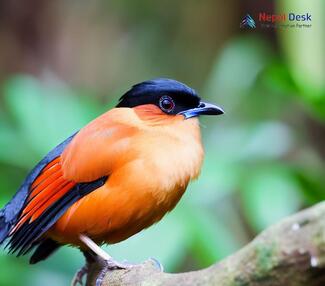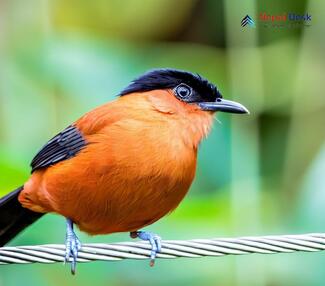Tucked away in the breathtaking scenery of Nepal is a diverse and flourishing bird population. Among this incredible range of bird species, the Rufous Sibia (Heterophasia capistrata) has stolen the hearts of bird enthusiasts and nature lovers alike. This mesmerizing bird, with its eye-catching feathers and enthralling presence, truly showcases the splendor and biodiversity exclusive to Nepal.
The Charismatic Appearance of the Rufous Sibia
The Rufous Sibia is a relatively petite passerine bird, identified by its vibrant hues and unique traits. Adults boast a primarily rufous coloration with a black head accompanied by an impressive and lengthy white crest. The underparts display a brilliant shade of orange which gently transitions into the deep rufous tone on their back and tail. Their mainly black wings are decorated with white patches that resemble streaks when in flight. Alongside these magnificent colors, their remarkably long tail adds graceful elegance to these stunning birds.
Habitat and Distribution within Nepal
The Rufous Sibia primarily resides in the Himalayas, ranging from Northern India to Bhutan and extending into parts of Nepal. These colorful birds can be observed throughout the year within their range, but sightings in Nepal are most common during spring or early autumn when they adapt to higher elevations. They favor forested areas, particularly those abundant with rhododendrons and mixed woodlands.
Rufous Sibias often frequent open canopies and woodland edges within their preferred habitat, spending time foraging among leaves or engaging in lively calls that echo throughout the trees.
Feeding Habits and Behavior
Rufous Sibias mainly consume berries, fruit, and small insects found within their woodland homes as a primarily frugivorous species. They are often witnessed in small groups hopping from one tree to another in search of sustenance, sometimes joining mixed-species feeding groups to encourage cooperation and improve foraging effectiveness.
These sociable birds are renowned for their animated calls and spirited displays. Their vocalizations comprise an amazing blend of tuneful whistles and melodious warbling, earning them a reputation as one of Nepal's most charming and unforgettable birds.
Conservation Status
At present, the Rufous Sibia is classified as a "Least Concern" species on the IUCN Red List. They maintain a fairly stable population throughout their distribution and display adaptability that has shielded them from major threats. In spite of this, habitat loss due to deforestation remains a potential concern for this captivating bird species.
In Summary
The Rufous Sibia truly stands out among Nepal's bird species, with its vivid colors and enigmatic behavior culminating in an extraordinary avian encounter. As a tribute to the abundant biodiversity nestled within Nepal's forests, the Rufous Sibia offers awe-inspiring experiences for birdwatchers and wildlife aficionados who explore this beautiful country.




